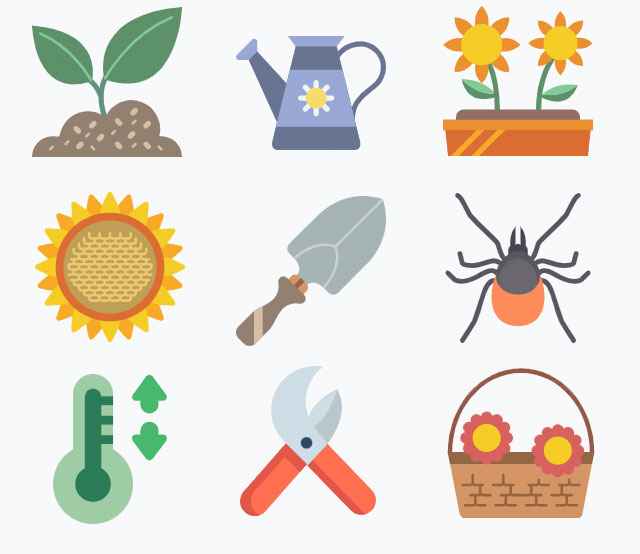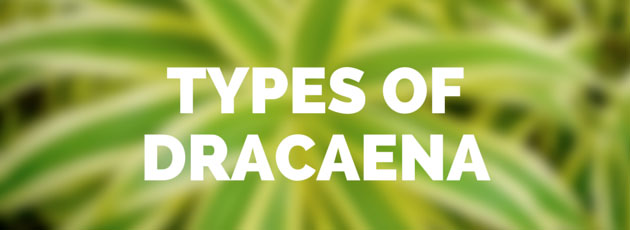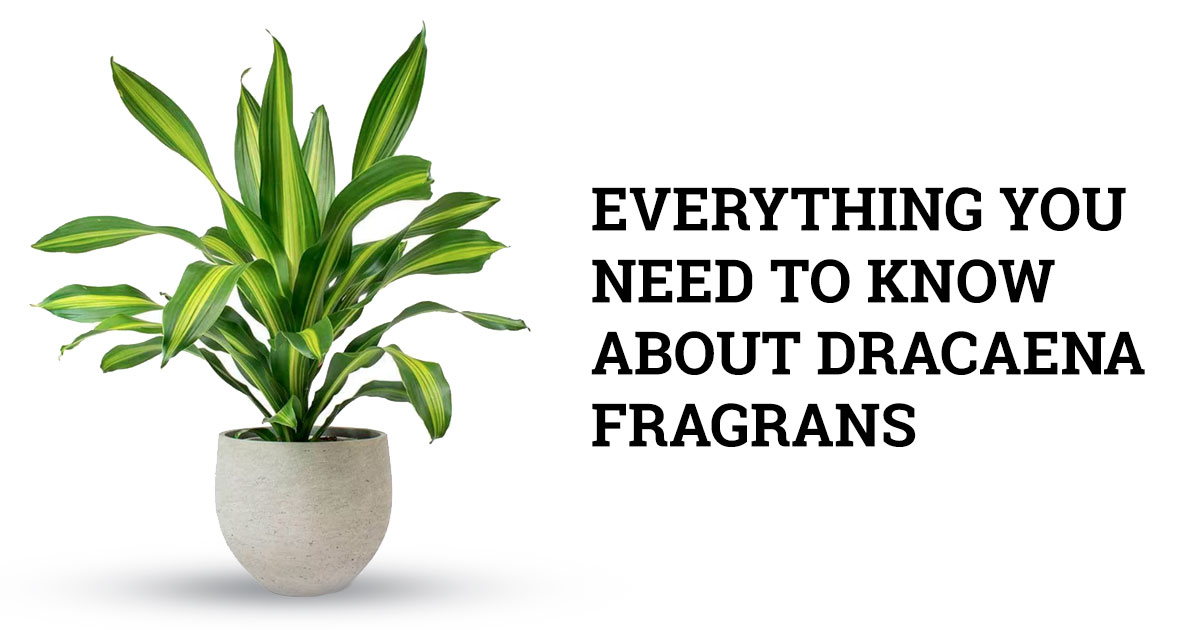When you know what to plant next to this or...
Dracaena Fragrans Care Guide (Corn Plant)
Dracaena Fragrans (also known as dracaena corn plant) is an evergreen ornamental deciduous plant with a long, sometimes branched stem. Under natural conditions, dracaena corn plant grows up to 6 m, and when kept as a houseplant - no higher than 1-2 m.
✔ We Released The Dracaena HandBook
CLICK HERE TO LEARN MORE >>
The leaves of dracaena Fragrans are glossy, curved, large, they can reach 60 cm in length, 10 cm in width, their color is green, monochromatic, or with various stripes or a border of light green, white, yellow. On both sides of dracaena corn plant leaves, slightly wavy at the edges, there is a central vein that is clearly distinguished.
A characteristic feature of Dracaena Fragrans (cornstalk dracaena) is a strong aroma from white or light green small flowers, reminiscent of the smell of freshly cut grass. Flowers bloom on a long, up to 90 cm, peduncle that grows from the center of the rosette, formed into small fluffy inflorescences with an intense smell. Like all dracaena varieties, corn plant Dracaena Fragrans does not bloom or rarely blooms as an indoor plant.
Dracaena Fragrans - Plant Care Guide
Dracaena Fragrans (cornstalk dracaena) is easy to care for, as it is quite unpretentious. However, for successful cultivation, dracaena corn plant requires compliance with certain care rules.

Lighting:
Dracaena Fragrans is more tolerant of lack of light than other dracaena varieties. Species with dark green monochromatic leaves grow well in the shade, but variegated forms in such conditions lose their brightness. Optimal for Dracaena Fragrans is bright diffused light without direct sunlight, located near the eastern or even southern windows, covered with a thin curtain.
With an excess of sun, the leaves turn yellow, the variegated color fades. For uniform development of the crown, turn the plant towards the light with the other side once every two weeks.
Watering:
Watering should be regular, Dracaena Fragrans needs to maintain constant soil moisture, while it does not tolerate overflow and stagnation of water. Dracaena corn plant should be watered on the average 2 times a week in summer and once every 10-12 days in winter.
Overdrying the substrate is also unacceptable, if a high temperature is maintained in the room in winter, it is better to increase the frequency of watering. It is useful to loosen the top layer of Dracaena Fragrans (corn plant) substrate once a month, which has a beneficial effect on the root system, increasing air access to it.
Temperature
Among other dracaena species, Dracaena Fragrans is the most hardy and it can withstand various temperature conditions. In summer dracaena corn plants can be taken out into the open air, but do not forget to protect them from drafts and direct sunlight. The temperature favorable for growth of Dracaena Fragrans is from 19°C to 25°C; in winter, the flower can withstand a temperature drop of up to +10°C.

Humidity
Dracaena Fragrans is demanding on air humidity, it requires daily spraying with water of room temperature, which will prevent yellowing of the tips of the leaves. If it is impossible to spray, place the plant on a tray with damp pebbles, and regularly add the water in it.
To remove dust, it is necessary to wipe Dracaena Fragrans with a damp sponge throughout the year; for the same purpose, you can arrange a warm shower for the plant.
All dracaena varieties do not tolerate leaf polishing agents well; it is possible to polish them occasionally, no more than 1 time in 2 months, using folk remedies (for example, alcohol, diluted citric acid, glycerin). You should not polish young, growing leaves. Expose the flower in the sun after the procedure to avoid burns.
Fertilizer
Dracaena Fragrans should be fed throughout the year, using complex floral or special fertilizers for dracaena and palms: twice a month in summer and monthly in winter, with a half dose. There should be a minimum amount of phosphorus in top dressing, since this element is usually accompanied by fluoride, which Dracaena Fragrans does not tolerate. In summer, if the temperature of the content exceeds +35°C, stop feeding the plant.
Repotting
Repotting should be done no more often than once every 2 years for young plants, and every 3-4 years for older ones. For large trees, it is sufficient to replace the top layer of the soil. To protect the root system from damage, be careful when repotting.
Provide the plant with good drainage and a special soil for palm trees and dracaena, to which you can add a part of the sand, as well as pieces of coal and brick chips. If the plant has grown and a larger pot is required, then it should be 10% larger than the previous one. The pot for Dracaena Fragrans needs to be heavy ceramic for the plant to be stable.
Pruning
Pruning should be done to Dracaena Fragrans to limit growth and form the crown. Cut the top of the plant so that 4-5 leaves remain on the trunk. To stimulate the formation of lateral shoots, close the cut site with polyethylene. A month later, young shoots will appear, and as they grow, remove the polyethylene.
Poisonous
Remember that Dracaena Fragrans is toxic to both cats and dogs. Do not allow your pets chew the leaves of the plant. It can cause weakness, vomiting and indigestion. At the first signs of poisoning, immediately bring your pet to a veterinarian. See more about pets and the effect toxins have here at the ASPCA.
How to propagate Dracaena Fragrans

- By cuttings. The most common way to propagate Dracaena Fragrans. To do this, use apical cuttings 10-15 cm long. In order for them to take root, use a substrate or containers with water and add activated carbon there to prevent decay processes. Cover the container with glass or foil. The plant takes root after 1 month. The best time to propagate Dracaena Fragrans is in spring or late summer.
- By stem cuttings. Cut the stem so that at least 2 buds remain in each part of it. The length of such cuttings can be different: from 5 to 15 cm. Root the cuttings using lightweight soil.
- From seeds. Dracaena Fragrans is not easy to grow from seeds, which is due to the rare flowering in everyday life. To get the seeds, it is necessary to artificially pollinate the flowers with a brush.
Diseases and pests of Dracaena Fragrans

Common Dracaena Fragrans diseases are:
- Rot (its different types) due to increased watering intensity, low temperatures
- Hypothermia
- Yellowing of leaves due to dry air
Dracaena Fragrans is most often exposed to such pests as spider mites, aphids, scale insects, and mealybugs. It is necessary to fight them with the help of insecticides. Additionally, increase the level of soil moisture. It is recommended to irrigate the plant with water from a spray bottle, since the parasites cannot tolerate high humidity.
However, with suitable conditions and good care Dracaena Fragrans is practically not affected by pests and diseases, it retains its decorative appearance for a long time and can serve as a decoration for any interior.
Care features and tips for Dracaena Fragrans (Corn Plant)
For Dracaena Fragrans, it is necessary to maintain a high humidity of the air, otherwise, the edges and tips of the leaves dry out.
The attractive appearance of the plant can be restored by cutting off the dried edges.
It is recommended to daily spray the plant with water of room temperature.
It is required to wipe the leaves with a wet sponge twice a month to remove dust on them. If for some reason daily spraying is not possible, you need to place the pot with the plant on a pallet with wet expanded clay, pebbles or peat. It is necessary to constantly add water to the pan in order to create the most comfortable conditions for keeping Dracaena Fragrans.
To keep the indoor plant neat and tidy, remove colorless and dried leaves from Dracaena Fragrans. Sometimes dracaena leaves become stained in the form of burns, which indicates insufficient watering, low humidity or oversaturation of the soil with fluorine and soluble salts.
To help the plant bloom at home, it is necessary to create conditions as close as possible to natural ones. In this case, put special attention to the temperature, air humidity, intensity of lighting and irrigation, frequency of feeding and amount of fertilization, pruning and repotting.
Problems when growing Dracaena Fragrans
- Dry tips and edges of leaves - most often this indicates dry air and poor watering. When such a problem arises, it is necessary to increase watering and the frequency of spraying the leaves with water. You can also more often arrange a warm shower for the plant, covering the substrate with a bag in order to prevent excessive moisture from getting to the roots.
- Yellowing of leaves - this may be the result of natural withering away (the lifespan of every leaf is about 1.5 - 2 years, after which it gradually dies off), this applies to the lower leaves and this is a rather slow process. If you are worried about the yellowing of the foliage as a whole, and not of individual lower leaves, then this may be the first symptom that your plant begins to die due to excess moisture in the pot. In this case, you need to take action. Remove your Dracaena Fragrans from the pot, dry the roots and remove those on which rot has appeared, then repot the plant into a new substrate. Also, yellowing of the foliage can indicate the exact opposite, that you forgot about your plant and it suffers from direct sunlight or a lack of nutrients in the soil, so change the plants location and try using fertilizers.
- Blanching of leaves - the plant can react in this way to both direct sunlight and a lack of light. If the leaves have not only turned pale, but also lost their brightness and the stripes have faded, then Dracaena Fragrans is still tired of shading.
- Withering leaves is an indicator of both over-watering and dryness of the soil. But it can also be a consequence of frostbite.
- Speckled light spots underside of the leaves - this indicates that you are using poor quality water for watering. I can recommend boiling the water before using it, or filtering it.
- Curling and blackening of leaf tips in Dracaena Fragrans occurs with prolonged low air temperature.
- Leaf wilting is most often caused by insufficient watering.
- Wet brown spots - over-watering.
Varieties of Dracaena Fragrans
This species has long been grown as an indoor plant, there are many varieties of Dracaena Fragrans of different sizes and colors of leaves, both monochromatic and variegated, with colored stripes and edging of leaf blades. Most often, as an indoor plant people prefer:

Dracaena Fragrans Massangeana
Dracaena Fragrans Massangeana, a large shrub up to 1.5 m high, growing in the form of a palm tree with decorative variegated leaves, decorated with a wide yellow stripe in the center and smaller ones along the edge.

Dracaena Fragrans Compacta
Dracaena Fragrans Compacta is distinguished by its compact size, a shortened stem and a solid dark green color of leaves formed into a dense bundle. There is also Compacta Variegata, with longitudinal yellow stripes. Monochrome varieties are prized for their ability to thrive in low light conditions.

Dracaena Fragrans Victoria
Dracaena Fragrans Victoria, with golden yellow broad stripes along the edge of the leaf.

Dracaena Fragrans Lindenii
Dracaena Fragrans Lindenii with wide white stripes and dark green Rotiana with narrow stripes of white or yellowish color along the edge of the leaf blades.

Less common are Dracaena Fragrans Lemon Lime, Kanzi and Surprise, with bright striped leaves, the latter variety is especially compact, not exceeding 20 cm in height.
Large dracaena varieties are suitable for decorating spacious office spaces, while small plants will look cozy in small rooms of an apartment. Hardy, elegant dracaena looks great in gardens. Enjoy the pleasure of having Dracaena Fragrans among your favorite indoor plants.
About the Author
My name is Michael Bauer, I have been growing and taking care of plants for 20 years. My dream has become a reality. I've had many difficulties along the way, but my love for our favorite plants has really helped me.So join us!


















